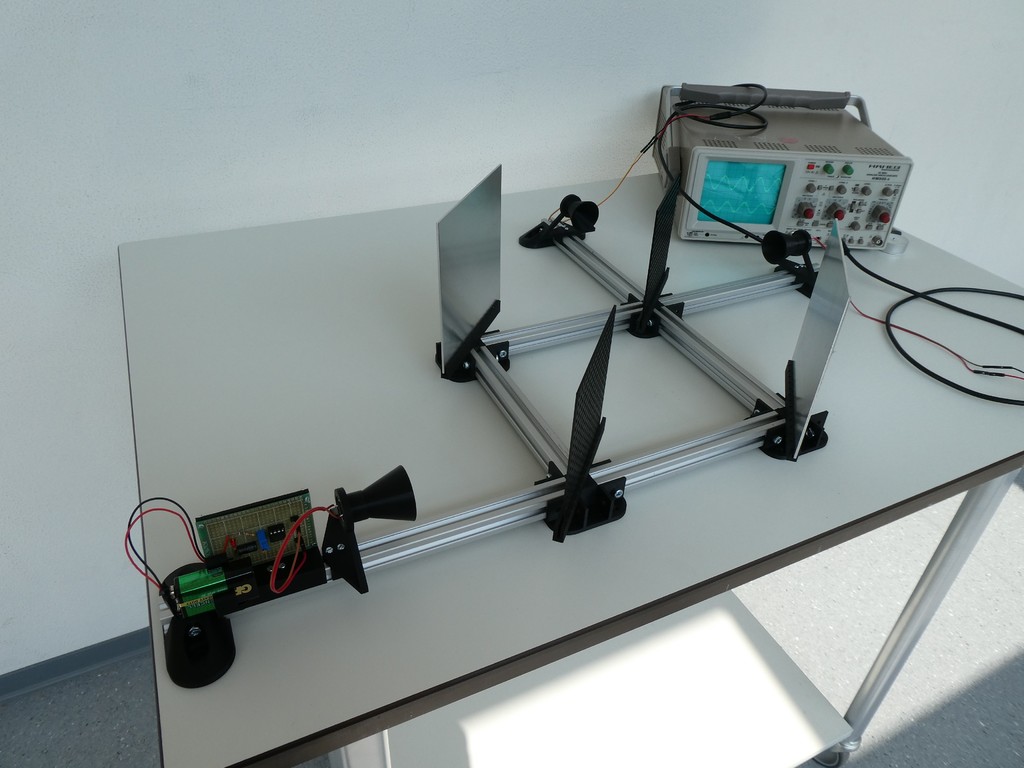
Ultrasonic experiments 7: Mach-Zehnder-Interferometer
thingiverse
### Ultrasonic experiments 7: Mach-Zehnder Interferometer ### I have developed a series of experiments with ultrasound waves that can be performed by students in upper-level physics lessons. These experiments include: 1. Reflection and Absorption of Ultrasonic Waves 2. Standing Waves 3. Interference with Two Transmitters 4. The Double-Slits Experiment 5. The Effect of a Semipermeable Plate 6. The Michelson Interferometer 7. **The Mach-Zehnder Interferometer** 8. Distance Measurement with an Arduino #### Components #### **Circuit Board Mount**: I used a 5cm x 7cm board, sufficient for the ultrasonic sound generator. I chose a standard circuit for the generator with the NE555. The electrical circuit is shown in a pdf file. The mount can be printed without support. **Mount for Horn**: This print is the mount for the transmitter horn and receiver horn. Support is not necessary. **Horn**: I chose an angle of approximately 20 degrees. Support is not necessary. **Base**: For this part, I used the excellent work of jandetlefsen and his thing http://www.thingiverse.com/thing:1412135. I could not find anything more suitable nor could I develop something better myself. Support is not necessary. **Nut M3**: A generic nut for M3 for the 20x20 aluminum profile system: You will need five of them. **Semipermeable Plate**: This semi-permeable plate consists of squares with a side length of 7 mm (an area of 50mm²) with a square cutout with a side length of 5mm (an area of 25mm²). **Connector**: ... to connect four 20x20 aluminum profiles. Support is not necessary. **Mount for Connector**: With a screw M3, this part can be movably mounted on the connector. Support is necessary. #### Things You Need More #### **Aluminum Profiles**: For this experiment, I recommend two (or three) 40cm long profiles for the input arm and output arm and four 25cm long profiles for the inner part of the interferometer. **Screws and Nuts**: A lot of M3 screws for mounting on the profiles (M3 x 10mm, M3 x 16mm). Some M5 screws and nuts for the bases. **Aluminum Plates**: I recommend two plates of 150mm x 150mm, with a thickness of 2mm. #### Results of the Experiment #### In the MZ interferometer, the incident wave is divided by the first semi-permeable plate into two equal parts. One half of the wave runs in the upper arm, and the other half of the wave runs in the lower arm. On the second semi-permeable plate, both waves are superimposed again. If both arms are of equal length, the overlay (regardless of which side of the semi-permeable plate is measured) is always constructive. This can be demonstrated with this experiment very clearly. By changing the wave (for example, with the gentle draft of a hair dryer) in only one arm of the interferometer, a change in the phase position (and thus a change in the output signal) can be achieved.
With this file you will be able to print Ultrasonic experiments 7: Mach-Zehnder-Interferometer with your 3D printer. Click on the button and save the file on your computer to work, edit or customize your design. You can also find more 3D designs for printers on Ultrasonic experiments 7: Mach-Zehnder-Interferometer.
